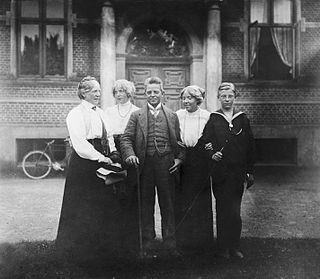Related Research Articles
Robert Wilfred Levick Simpson was an English composer, as well as a long-serving BBC producer and broadcaster.

Ludwig van Beethoven's Piano Sonata No. 8 in C minor, Op. 13, commonly known as Sonata Pathétique, was written in 1798 when the composer was 27 years old, and was published in 1799. It has remained one of his most celebrated compositions. Beethoven dedicated the work to his friend Prince Karl von Lichnowsky. Although commonly thought to be one of the few works to be named by the composer himself, it was actually named Grande sonate pathétique by the publisher, who was impressed by the sonata's tragic sonorities.

The Symphony No. 94 in G major is the second of the twelve London symphonies written by Joseph Haydn. It is popularly known as the Surprise Symphony.

The String Quartet No. 1 in F major, Op. 18, No. 1, was written by Ludwig van Beethoven between 1798 and 1800, published in 1801, dedicated to the Bohemian aristocrat Joseph Franz von Lobkowitz. It is actually the second string quartet that Beethoven composed.

Ludwig van Beethoven's Symphony No. 1 in C major, Op. 21, was dedicated to Baron Gottfried van Swieten, an early patron of the composer. The piece was published in 1801 by Hoffmeister & Kühnel of Leipzig. It is not known exactly when Beethoven finished writing this work, but sketches of the finale were found to be from 1795.

The Symphony No. 2 in D major, Op. 36, is a symphony in four movements written by Ludwig van Beethoven between 1801 and 1802. The work is dedicated to Karl Alois, Prince Lichnowsky.

Asger Hamerik (Hammerich) was a Danish composer of the late romantic period.

The Symphony No. 7 in C major, Op. 105, is a single-movement work for orchestra written from 1914 to 1924 by the Finnish composer Jean Sibelius.

Agnus Dei(Lamb of God) is a choral composition in one movement by Samuel Barber, his own arrangement of his Adagio for Strings (1936). In 1967, he set the Latin words of the liturgical Agnus Dei, a part of the Mass, for mixed chorus with optional organ or piano accompaniment. The music, in B-flat minor, has a duration of about eight minutes.

Symphony No. 67 in F major, Hoboken I/67, is a symphony by Joseph Haydn. It was composed by 1779. The Haydn scholar H. C. Robbins Landon calls this work "one of the most boldly original symphonies of this period."
The String Quartet No. 14 in A♭ major, Op. 105, B. 193, was the last string quartet completed by Antonín Dvořák, even though it was published before his String Quartet No. 13. Dvořák finished his Fourteenth Quartet in 1895, when he had returned to Bohemia after his visit to America. The gestation of the Quartet had actually begun in America and lasted six months, which was rather protracted for the composer. This Quartet marked an important point in Dvořák's development because he would devote himself almost exclusively to writing explicit program music, namely symphonic poems and operas, afterwards.
The String Quartet No. 2 in A minor, Op. 13, was composed by Felix Mendelssohn in 1827. Written when he was 18 years old, it was, despite its official number, Mendelssohn's first mature string quartet. One of Mendelssohn's most passionate works, the A minor Quartet is one of the earliest and most significant examples of cyclic form in music.
An organ concerto is an orchestral piece of music in which a pipe organ soloist is accompanied by an an orchestra, although some works exist with the name "concerto" which are for organ alone.

Carl Nielsen's String Quartet No. 4 in F major or Quartet for Two Violins, Viola and Cello in F major, Opus 44, was composed between February and July 1906. The last of Nielsen's four string quartets in the official series, its first public performance took place on 30 November 1907 in Copenhagen.
Ruralia hungarica is a name given by the Hungarian composer Ernő Dohnányi to four interrelated works.
Felix Mendelssohn wrote thirteen string symphonies between 1821 and 1823, when he was between 12 and 14 years old.. These symphonies were tributes to Classical symphonies especially by Joseph Haydn, Johann Christian Bach, Carl Philipp Emanuel Bach, and Wolfgang Amadeus Mozart.
The Terzetto in C major, Op. 74 (B. 148), is a chamber work for two violins and viola by the Czech composer Antonín Dvořák, published in 1887.
George Dyson's Psalm CVII Symphony and Overture, is a choral symphony written in 1910 as part of the composer's studies at Oxford for his Doctorate in Music. Not rediscovered until 2014, it is one of the few compositions surviving from the composer's early years.
The String Sonata No. 1, commonly referred to by its original Italian name Sonata per archi, is a composition for string orchestra by German composer Hans Werner Henze. It was composed between 1957 and 1958.
Ferdinand Ries composed his Violin Sonata in E-flat major, WoO. 7 in 1804, when he was 22 years old. Surviving in manuscript form in the Berlin State Library, there is no evidence the work was performed during the composer's lifetime and was amongst a number of compositions that remained unpublished at the composers death.